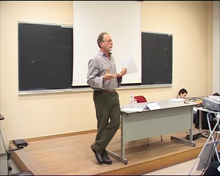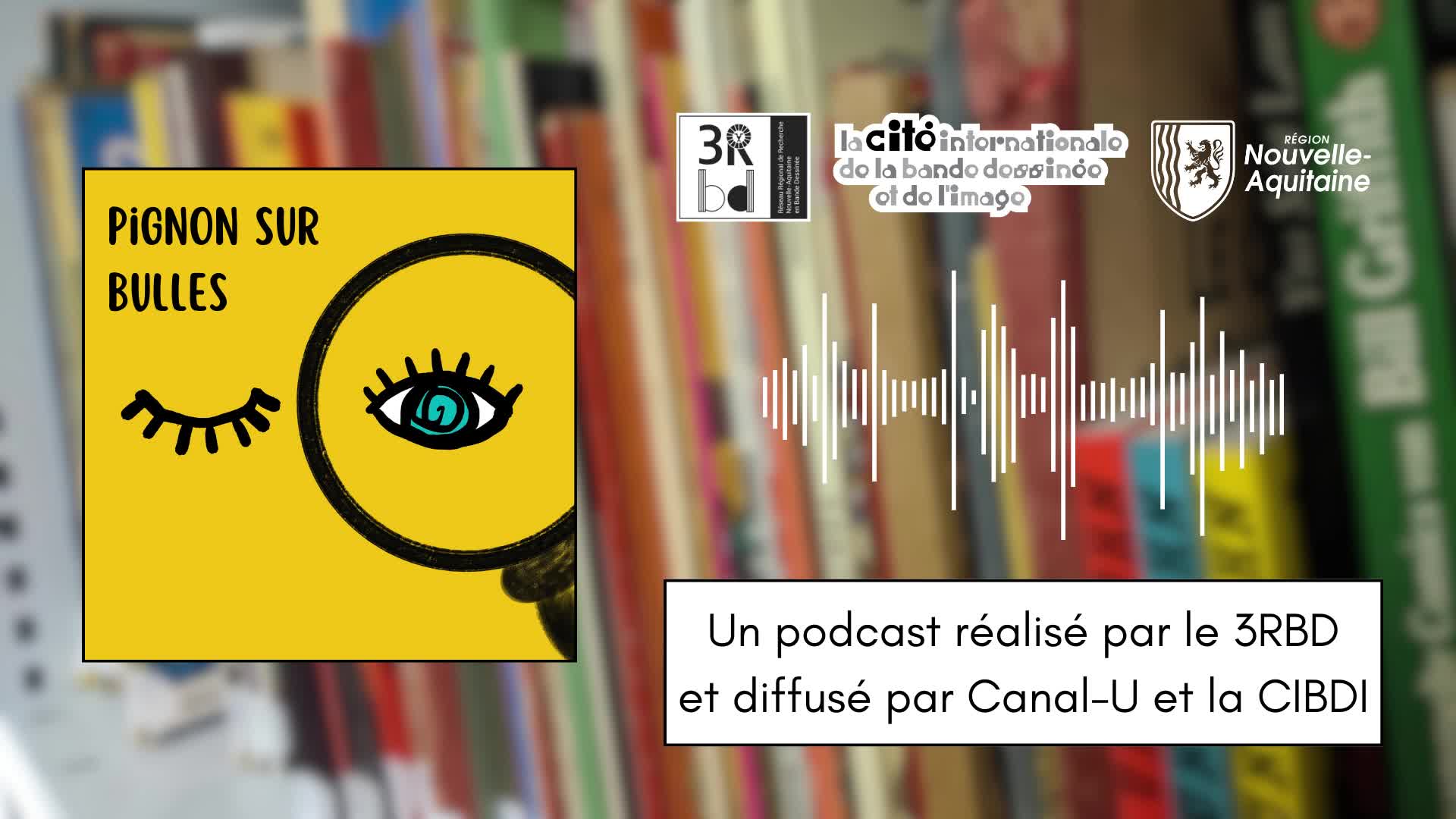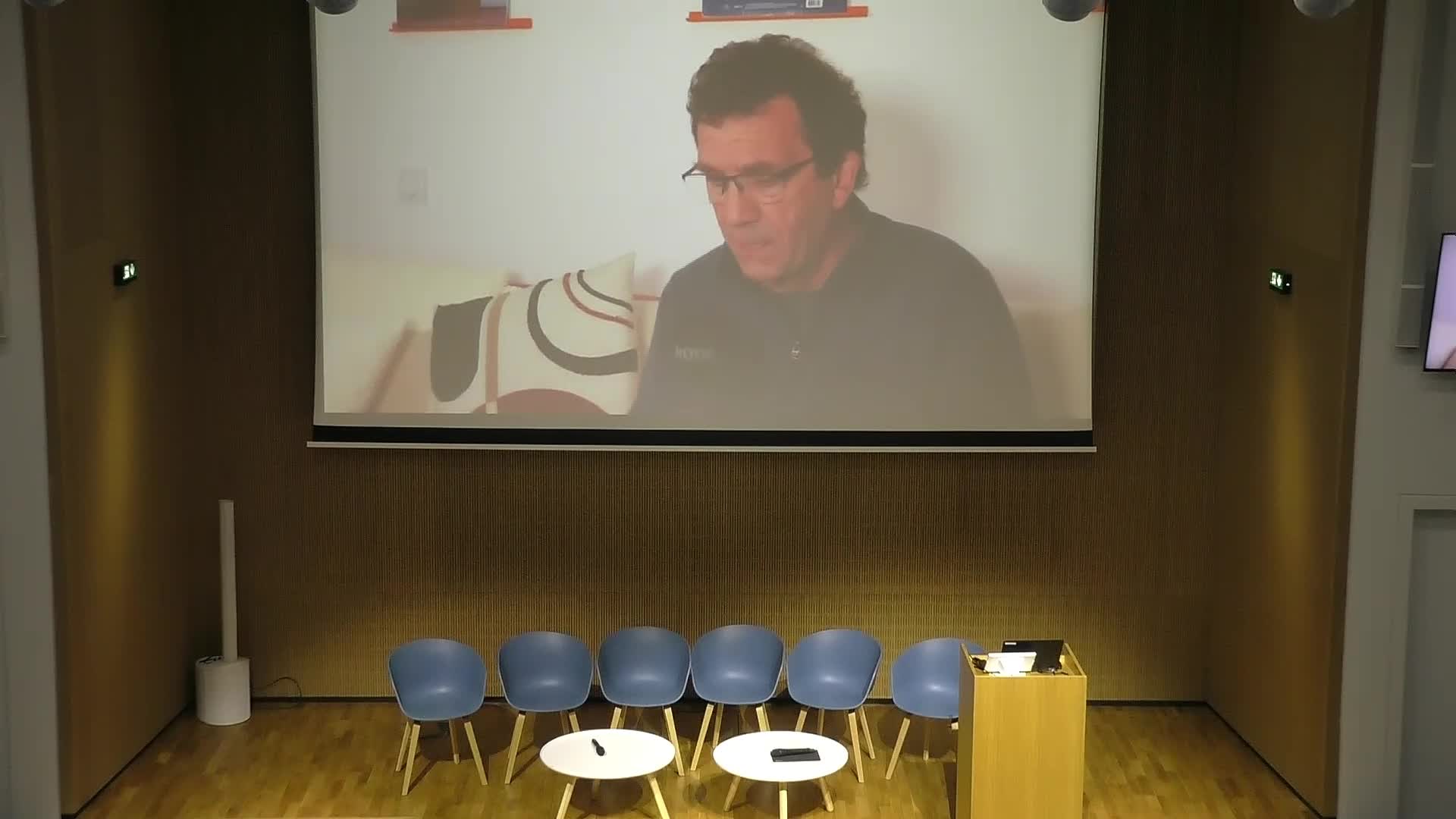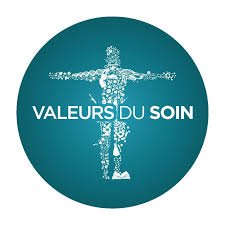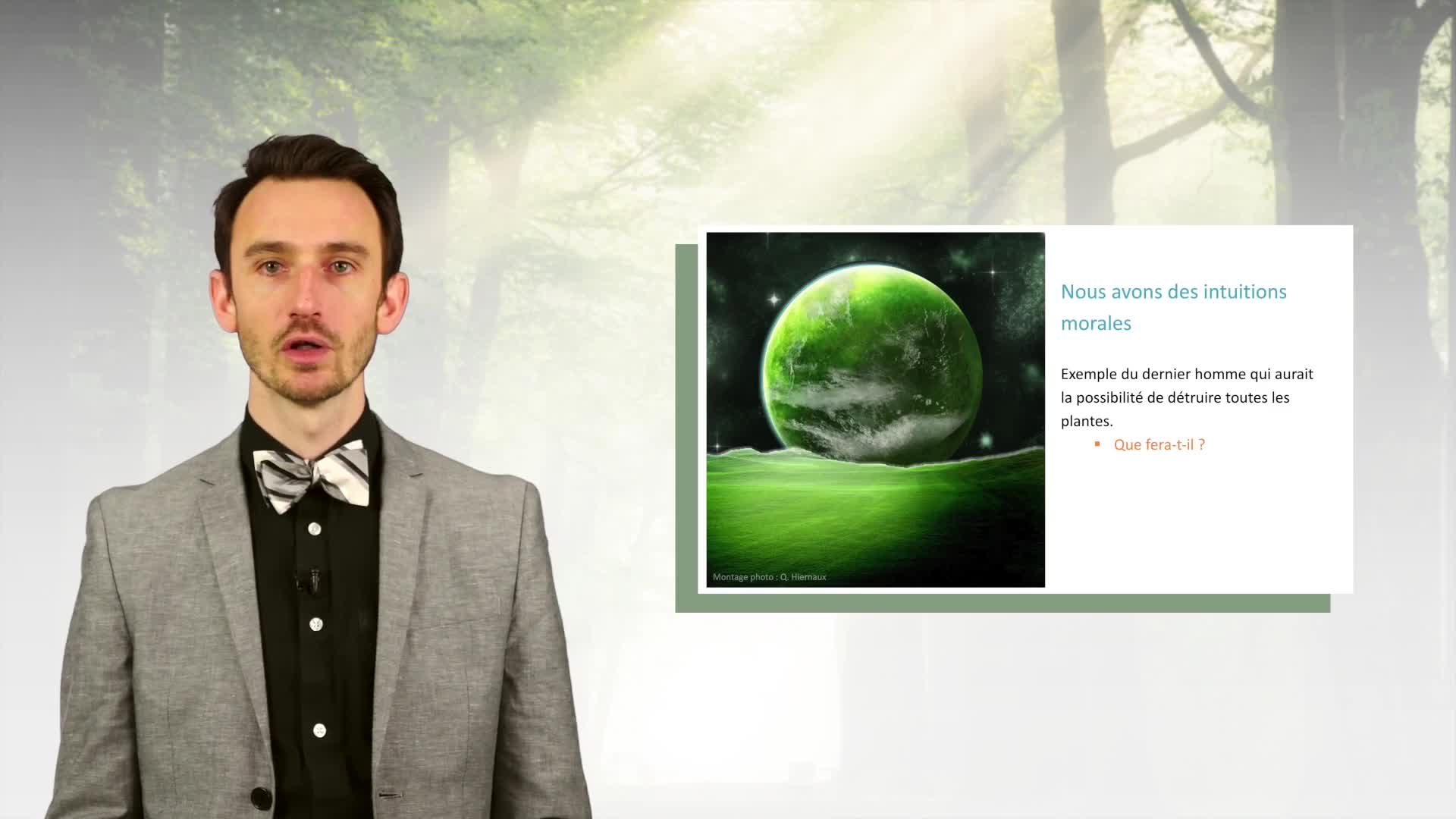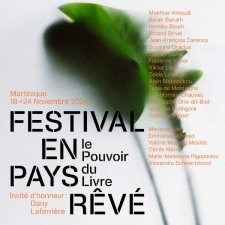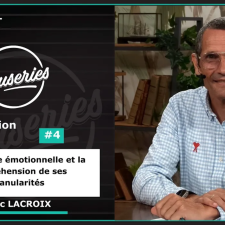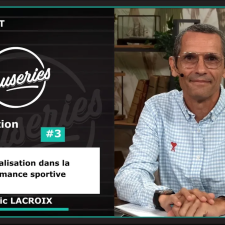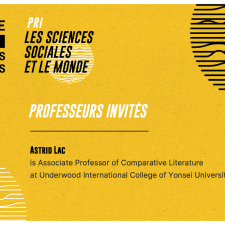Notice
The Ontogenetic Emergence of Co-operative Communication
- document 1 document 2 document 3
- niveau 1 niveau 2 niveau 3
Descriptif
Thème
Documentation
Résumé des conférences
Lecture 1: The Intentional Communication of Great Apes
Lecture 2: The Co-operative Communication of Human Beings
Lecture 3. The Early Ontogeny of Co-operative Communication
Lecture 4. Language as Shared Intentionality
Lecture 1: The Intentional Communication of Great Apes
Ape gestural communication flexible, intentional, but not co-operative (no shared intentionality).
- Biol. comm. = any physical or behavioral feature that evolved to influence others
- Need equilibrium of costs & benefits for Comm. (C) & Audience (A)
- EG: angler fish, duck mating displays
- Communicator = behavioral manipulation <=> Audience = information
1.1. Great Apes' Vocalizations and Gestures
- Displays = genetically fixed <=> Signals = flexible, voluntary
- Vocalizations = displays
- Unlearned & inflexibly used
- no indiv diff; isolation exps; cross- fostering exps
- inflexibly used: particular situations and emotions
- do not learn new vocalizations (even w/ with humans)
- Goodall: "The production of a sound in the absence of the appropriate emotional state seems to be an almost impossible task for a chimpanzee"
- Broadcast to all: audience effects = presence/absence of kin (at best)
- e.g., call even when whole group is there (predator, food)
- Evolutionarily urgent functions ==> high emotions
- e.g., vervet alarm calls: [apes = no referentially specific calls]
- A = extract information (learn bird alarms)
- C = cause behavior: predator retreats; kin run to safety
- Seyfarth & Cheney (2003, p. 168): "Listeners acquire information from signalers who do not, in the human sense, intend to provide it."
- Vocal comm. basically same in all mammals (ground squirrels, dolphins)
- Gestures = signals
- Many genetically fixed postures & facial expressions
- But some: less evolutionarily urgent functions ==> relaxed emotions
- e.g., play, riding, nursing, begging, grooming
- Flexible Use [analogy: tool use]
- learned: individual differences; novel (idiosyncratic) gestures, new gestures with humans (see below)
- flexibly used: means-ends dissociation
- combinations/sequences
- ontogenetic ritualization, not imitation
- sequence: (i) C does X; (ii) A anticipates by doing Y at int. move.; (iii) C notices this, and just produces int. move.
- evidence: group comparisons; experiment
- no imitation: gestures = one-way, not shared (¿convention?)
- Attention to the attention of the partner
- Directed at individual recipients (not broadcast)
- much evidence: visual gestures only when A attending
- Visual modality: focus on attentional state of partner
- A: is it directed to me? C: Is she attending?
- Type I: Intention movements: und. others' goals
- e.g., arm-raise, touch-side: I want you to do X.
- imperative, dyadic (food-beg as exception; object 'offer')
- metonymic (no iconic) => function/meaning internal to activity
- supposed gorilla examples of iconic
- Type II: Attention getters: und. others' perception
- to obtain attention on displays: I want you to see me [do X]
- e.g., leaf clipping (erection), throw stuff (play face)
- function/meaning from display
- chimp and gorilla examples of hiding displays
- auditory attention getters: only African apes
- make noise without emotion
- to obtain attention to body part or object: groom, play, food
- I want you to see: ¿Gricean claim of attention?
- apes do not produce sequence: att-getter + intention-movement
- walk around (observations, experiment): esp. Pan
- Comparison: ape gestures more cognitively sophisticated (closer to language) than vocalizations => based on und. that others have goals & perceptions
- Learned, flexible, novel, creative combinations (vocal = no)
- Chosen w/r/t attentional state of the recipient (vocal = no)
- and use of attention getters, walking around
- More sophisticated in apes than in monkeys (vocal = opposite)
- But not conventions => not shared, only one-way (not imitated)
- But no pointing or iconic gestures: not even when want something
- Not collaborative (no requests for clarification)
1.2. Great Apes and Pointing
- Approx. 60-70% of captive chimps point imperatively for humans
- to out-of-reach food, w/ persistence, when human looking
- nothing systematic w/ vocalizations (auditory att-getters: yes)
- point to tool, so humans can use it to get them food [C&T, '94]
- so human can use it for self? (so far = no)
- point to where food was hidden many hours before
- Kanzi combines pointing with lexigram to specify who
- others: bring human to place where she can help; give human locked box for help; put human's hand on pocket => analogy = tool-use
- no declarative (sharing) pointing; no informative (helping) pointing
- no characterizing gestures; but can be taught ASL signs = imperative
- ¿What are these points? And why for humans, but not for conspecifics?
- conspecifics competitive <=> humans helpful
- human evol.: imperative pointing when others become helpful
- Comprehending pointing
- Apes can follow gaze or pointing gesture to, e.g., food (no inference)
- But apes terrible in object choice, w/ food hidden; Why?
- kids good at 12-14 mos.
- Hare & T competitive object choice experiment
- und. goal & perceptions of other (in competition)
- make inference about goal of reaching
- Herrmann & T => "Don't!" experiment => inference from prohibition
- ¿ und. indiv. imperatives?
- Next Lecture: not missing und. of intentionality [goal, percept, act]
- but missing shared intentionality: joint attention, communicative intention (relevance to JAF), cooperative motive to share info.
- Sidebar on domestic dogs (and foxes) => skills in obj choice
- wolves, undom. foxes => no skills
- Rico 'words': frame is always "Fetch!" (natural + trained)
- new experiment w/icons
1.3. Summary: Ape Gestural Communication
- Ape gestures => intentional communication: (i) flexible, (ii) audience design
- Based on und. goals & perceptions of others (vocal. = no!)
- Intention movements - function/meaning inherent if und. goals
- Attention getters - function/meaning inherent if und. displays (+percept)
- But not co-operative comm. b/c no skills & motivations of shared intentionality
- Gestures one-way (not imitated), not collab. (no reqs. for clarification)
- Helpful partner leads apes to indiv. imperatives, but not co-op. comm.
Some References
Call, J. & Tomasello, M. (1994). The production and comprehension of referential pointing by orangutans. Journal of Comparative Psychology, 108, 307-317
Call, J. & Tomasello, M. (Eds). (in press). The gestural communication of apes and monkeys. Erlbaum.
Call, J. & Tomasello, M. (1996). The effect of humans on the cognitive development of apes. In A. Russon, K.A. Bard, S.T. Parker (Eds.), Reaching into Thought: The Minds of the Great Apes. Cambridge U Press.
Hare, B., Call, J., & Tomasello, M. (in press). Chimpanzees deceive a human by hiding. Cognition
Hare, B. & Tomasello, M. (2004). Chimpanzees are more skillful in competitive than in cooperative cognitive tasks. Animal Behaviour, 68, 571-81
Hare, B., Brown, M., Williamson, C., & Tomasello, M. (2002). The domestication of social cognition in dogs. Science, 298, 1634-36.
Hermann, E. & Tomasello, M. (in press). Apes' and children's understanding of cooperative and competitive motives in a communicative situation. Developmental Science.
Liebal, K. , Pika, S. & Tomasello, M. (2006). Gestural communication in orangutans. Gesture, 6, 1 - 38.
Liebal, K., Call, J., & Tomasello, M. (2004). The use of gesture sequences by chimpanzees. American Journal of Primatology, 64, 377-396.
Liebal, K., Pika, S., Call, J., & Tomasello, M. (2004). To move or not to move: How apes adjust to the attentional state of others. Interaction Studies, 5, 199-219
Pika, S. , Liebal, K., & Tomasello, M. (2003). Gestural communication in gorillas. American Journal of Primatology, 60, 95-111.
Pika, S. , Liebal, K., & Tomasello, M. (2005). Gestural communication in bonobos. American Journal of Primatology, 65, 39-61.
Pika, S. , Liebal, K., Call, J., & Tomasello, M. (2005). Gestural communication of apes. Gesture, 5, 41 - 56.
Tomasello, M. (1996). Do apes ape? In J. Galef & C. Heyes (Eds.), Social Learning in Animals: The Roots of Culture. Academic Press
Tomasello, M. & Call, J. (1997). Primate Cognition. Oxford University Press.
Tomasello, M. & Camaioni, L. (1997). A comparison of the gestural communication of apes and human infants. Human Development, 40, 7-24.
Tomasello, M. (in press). Why don't apes point? N. Enfield & S. Levinson (Eds.), Roots of Human Sociality. Wenner-Grenn.
Tomasello, M., Call, J., & Gluckman, A. (1997). The comprehension of novel communicative signs by apes and human children. Child Development, 68, 1067-1081.
Tomasello, M., Call, J., Nagell, K., Olguin, R., & Carpenter, M. (1994). The learning and use of gestural signals by young chimpanzees: A trans-generational study. Primates, 37, 137-154.
Tomasello, M., Call, J., Warren, J., Frost, T., Carpenter, M., & Nagell, K. (1997). The ontogeny of chimpanzee gestural signals: A comparison across groups and generations. Evolution of Communication. 1, 223-253.
Tomasello, M., Call, J., & Hare, B. (2003). Chimpanzees understand psychological states: The question is which ones and to what extent. Trends in Cognitive Science, 7, 153-156
Tomasello, M & Zuberbüler, K. (2002). Primate vocal and gestural communication. In M. Bekoff, C. Allen, & G. Burghardt (Eds), The Cognitive Animal: Empirical and Theoretical Perspecitives on Animal Cognition. MIT Press.
Lecture 2: The Co-operative Communication of Human Beings
Human co-operative gestures emanate from skills and motivations of shared intentionality.
- Human beings are inordinately co-operative: evolutionary anamoly
- Communication: "whites of the eyes" analogy; share info
2.1. Machievellian vs. Vygotskian Intelligence
- Ape cognition adapted for competition
- Early studies of ape ToM in co-op. paradigm => failure
- Studies of Hare et al. (2000, 2001) in comp. paradigm => success
- Hare & Tomas competitive Obj Choice (Lecture 1)
- Apes und. perception, goals, acts (+knowledge, not false beliefs)
- Human cognition, in addition, adapted for co-operation & cultural life
- Shared Intentionality: (i) Skills = shared ('we') goals/intentions, attention/knowledge; (ii) Motivations = helping, sharing
- Co-operation: apes in Melis et al '06 collaborate; in W&T '06 help
- but no shared goal in Warneken & T in press (videos)
- but no comm. during collaborative actions
- Social Learning : apes have some skills of social learning
- but human imitation, instructed, & normative learning (video)
- Communication : e.g., pointing gesture
- hypothesis: co-op comm. key also to collab. & soc. learn.
2.2. Human Pointing Fundamentals
- By itself, pointing is nothing!
- Table 1a examples: if you look over there, you'll know what I want (mindreading)
- Characterizing gestures: Table 1b examples
- The JA frame: common ground (diff levels a la Clark)
- no frame = no meaning (although 'crying child' example)
- different frames = different meanings (ex: bucket as location or as plastic)
- perspectival , in a sense
- must be shared (ex: plastic as fetish) => common ground
- can involve absent referents ('missing belt' example)
- Communicative act: 3 levels of intentions (+ indiv. goals)
- Social intention (motive, speech act goal):
- requestive: that you do X [to help me]
- informative: that you know X [to help you]
- expressive: that you feel X [so we can share, id w/ one another]
- also: greeting; gratitude; guilt; & other ¿expressives?
- referent = my feeling [but no pointing!]
- Communicative intention : that we know together that I am attempting to communicate - so that you will attend to the referential act and thereby infer my social intention [mutually manifest, public => hidden authorship]
- co-operative effort that you understand (Clark)
- Referential intention: that you attend to my referent and to my expression of motive [either may be omitted in familiar context, e.g., dentist]
- pointing directs other to referent spatially
- expression of motive by face, voice, body
- Individual Goals : many layers
- to pursuade, to insult, to deceive; but also to get/eat apple
2.3. Model Based on Primitives
- Figure 1
Primitives of co-op communication:
- Basic primate perceptual & cognitive skills => world
- logic of intentional/rational action (+ causality) => reasons
- Persons: I, You, We
- Psychological States: (i) do, (ii) want/goal/intend, (iii) see/attend/know, (iv) feel
- Basic Schema = I want: we know: I want: you do/feel/know X
- Assumption of Helpfulness: help = I want: [you see:] world = your goal
- generates both relevance inferences and obligations
- Most general communicative motives = helping and sharing
- Request Action/Info (Get Help): I want: you help me
- Offer Action/Info (Help): I want: I help you
- Express/Share: I want: we do/feel/know X
- Specialty Motives: greeting, thanking, apologizing
- Return to apes in object choice
- Hare & T competitive object choice => apes und. goal of reaching
- Also: Herrmann & T "Don't!" experiment => und. behavioral prohibitions
- No: (1) joint attentional frame (JAF) for reference
(2) und. of ['we'] communicative intention for relevance
(3) und. of motive to help by informing
- So, not missing und. of intentionality, but shared intentionality
- Human evol.: declarative and informative pointing when shared intentionality (and imperatives become co-operative)
2.4. An Evolutionary Fairy Tale
- Stage 1: Homo: Imitation of tool making: conformity norms
- also: analysis of rational action: decision-making (Gergely et al., 2002)
- quantitative, not qualitative, difference to apes
- Stage 2: Homosapiens: Shared Intentionality
- Mutualism - indirect reciprocity [reputation] - strong reciprocity [norms]
- Selection for collaborative activities [many mutualistic]
- Social-cognitive skills: shared goals, intentions, attention
- Social-cognitive motivations
- helping => indirect reciprocity [reputation > gossip] =>
strong reciprocity [ social norms for helping] - sharing: identify w/ others of group, bonding/intimacy, gossip
- Co-operative Communication
- Making public desires and knowledge in co-op. communication
- relevance based on assumption of helpfulness
- Imperative: C advertises request for help
- A responds b/c enhances reputation for helpfulness
- C thanks b/c enhances reputation as advertising partner
- Informative: C advertises own helpfulness (w/r/t providing info.)
- A accepts help (& thanks in some cases)
- Expressive/Sharing: C & A bond, identification [gratitude, greeting, etc.]
- Social norms on helpfulness = public obligations
- A cannot ignore invitation to communication [or insane]
- C&A cannot not help when low cost [or anti-social]
- Attention-getter to co-op. pointing => JAF (triadic) + comm. intention (we)
- New motives to help and share => offering, informing, sharing
- Indiv. imperative to co-op imperative: C & A mutually helpful
- Int. movment to co-op. char. gesture: => JAF (triadic) + comm. intention (we)
- imitation => convention
|
Shared Intentionality |
|
|
- JA Frame - Comm. intention |
|
|
- Mutual help + share - Imitate/Convention
|
|
- Transition to linguistic symbols
- Characterizing gestures (for actions & absent refs) => observed from outside JAF ('spear' ex., esp. children) and imitated as symbols
- Points turn into demonstratives and other deictics
2.5. Summary: Human Co-operative Communication
- Humans communicate by publically expressing their thoughts, feelings, desires
- Assumes a generally helpful social world [norms]
- Assumes social world concrnd w/ reputation & group cohsion => gossip
- Shared intentionality infrastructure: (i) Skills = shared ('we') goals/intentions, attention/knowledge; (ii) Motivations = helping, sharing
- Pointing most basic form of co-op comm. [char. gestures for actions & absent refs]
- Possible foundational role of co-op. comm. in other forms of Shared Int.: collaboration & cultural learning (esp. instructed and normative learning)
Some References
Hare, B., Call, J., & Tomasello, M. (2001). Do chimpanzees know what conspecifics know? Animal Behavior, 61, 139 - 151
Hare, B., Call, J., Agnetta, B., & Tomasello, M. (2000). Chimpanzees know what conspecifics do and do not see. Animal Behaviour, 59, 771-785..
Hare, B., & Tomasello, M. (2005). Human-like social skills in dogs? Trends in Cognitive Science, 9, 439-444.
Melis, A., Hare, B., & Tomasello, M. (2006). Chimpanzees recruit the best collaborators. Science, 31 ,1297 - 1300.
Tomasello, M. (1999). The Cultural Origins of Human Cognition. Harvard University Press
Tomasello, M., Call, J., & Hare, B. (2003). Chimpanzees understand psychological states: The question is which ones and to what extent. Trends in Cognitive Science, 7, 153-156
Tomasello, M., Carpenter, M., & Liszkowski, U. (submitted). A new look at infant pointing.
Tomasello, M., Carpenter, M., Call, J., Behne, T., & Moll, H. (2005). Understanding and sharing intentions: The origins of cultural cognition. Behavioral and Brain Sciences, 28, 675 - 691.
Tomasello, M., Kruger, A., & Ratner, H. (1993). Cultural learning. Behavioral and Brain Sciences, 16, 495-552.
Warneken, F., Chen. F., & Tomasello, M. (in press). Cooperative activities in young children and chimpanzees. Child Development.
Wyman, E. & Tomasello, M. (in press). The ontogenetic origins of human cooperation. In L. Barrett & R. Dunbar, Handbook of Evolutionary Psychology.
Warneken, F. & Tomasello, M. (2006). Altruistic helping in human infants and young chimpanzees. Science, 31 ,1301 - 1303.
Table 1a. Some observed examples of adult pointing.
1. It's over there.
2. Let's go in this direction
3. Don't forget that.
4. You dropped that.
5. Look at that!
6. Could I have that?
7. Put it here.
Point + insistent |
In airplane, one person points to two empty seats for another person down the aisle. Gloss: "Here's two empty seats together!" |
Point + neutral |
I give a book to another person as a gift." Since this was unusual, she asked why. I pointed to a stack of five other copies on my desk. Gloss: "I have a bunch of them so you may as well have one". |
Point + neutral |
Standing in line at the bank, one person points for another in the adjacent line to a scarf she has inadvertently dropped on the floor. Gloss: "You dropped that." |
Point + stern |
On a river bank next to a noisy waterfall, a person hands me a book up (I am on top) for safekeeping as she climbs up. She points to the tip of a pencil protruding from the book. Gloss: "Don't let this fall out". |
Point + neutral |
In a bar, to a bartender, a person simply points to his empty shot glass. Gloss: "I'll have another". |
Point + questioning |
In airplane, I am standing up idly near the bathrooms. A man approaches and points to the bathroom door with a quizzical expression. Gloss: "Are you waiting for the bathroom?" |
Point + neutral |
In airplane, the flight attendant asks me if I want tea. The guy next to me had asked for some a few minutes before (he was now distracted), and so I simply point to him. Gloss: "He'll take you up on your offer". |
Point + questioning |
In lecture, I cannot find the place on the handout referred to by the lecturer. I look quizzically onto my neighbor's handout, and she points to the correct place on her handout. Gloss: "What you're looking for is here". |
Point + insistent |
One person to another in line, informing them of a gap in the line ahead of them. Gloss: "Hey. Move up." |
Point + apologetic |
I approach my parked car and a truck has it blocked in. I look to the driver with an apologetic expression (shoulders shrugged and facial expression) and point to my blocked-in car. Gloss: "Sorry, but you have to move to let me out". |
Point + questioning |
Maitre'd: should I put your name on this list? |
Lecture 3. The Early Ontogeny of Co-operative Communication
Infants' co-operative gestures have full adult structure from their outset.
- Some think infants' early pointing not "real thing"
- Here: yes, both in terms of structure and motivation => BEFORE LANGUAGE
3.1. Early Pointing at 12 Months
- Infants social initially only dyadically => 9-month revolution
- Joint Attentional Frame
- Comp: Behne et al. (2005a) object choice - 12-14 mos.
- Comp: Liebal et al. (in prep) on shifting JAFs - 18 mos.
- control cond: frame must be shared!
- Production: Table 2a [12-13 mos.]
- point to table vs. chair for same function
- Referential Intention
- Moore's challenge: infants point when A already looking
- Liszkowski et al. (2004) - 12 mos. => need target
- Liszkowski et al. (submitted a) - 12 mos. - misunderstand referent
- need specific target
- Liszkowski et al. (submitted b) - 12 mos. - absent referents
- see also Table 2a
- Golinkoff: negotiation of meaning at 10-18 mos.
- Social Intention (Motive)
- Expressives: I want: we know: I want: we feel X
- 12 mos: Liszkowski et al (2004): sharing attention & attitudes
- 12 mos: Liszkowski et al (sub a) - wrong attitude
- Informatives: I want: we know: I want: you know X
- 12-14 mos: Behne et al. (2005a) - comprehend informative
- 12 mos: Liszkowski et al (2006) produce informative
- Liszkowski et al (in prep) follow up on 'knowledge'
- Requestives: I want: we know: I want: you do X
- 11-12 mos: Camaioni (co-operative or individual?)
- 24 mos: Schwe-Behne - co-operative imperative
- No pointing for greeting, thanking, apologizing
- referent = my feeling
- w/ language: all early, 18 mos. (comprehension?)
- Communicative Intention [¿really?]
- Not hidden authorship, but something more primordial
- Adults want infants to do things; infants know this
- learn to direct things to others: eye contact, etc.
- Albrecht et al: 12 mo. olds know that others must see gesture
- Behne et al. (2005a) control condition at 14 mos. - see as not communicative
- in experimental condition make relevance inference
- Liszk (sub b): 12-mo-olds point still after sharing w/ adult (to stress comm?)
- Shwe-Behne: 2 yr olds correct misund. even when get what want
- Moll & T - 14-mos. know what we experienced together
- Characterizing gestures
- Early ritualizations: reject, put--me-down, pick-me-up (like apes, 1-way)
- Diary examples, Table 2b
- taught baby signs = like words; iconic? invented?
- spontaneous examples in Table 2b
- Understand such gestures for objs (not replicas) by 18 mos (T et al, '99)
- for 'actions I should do' by 30 mos (Haimerl in prep) (videos)
3.2. The Early Ontogeny of Pointing
- Infants have pointing hand-shape at 3 to 6 months (Hannan, 1987)
- Infants solicit adult help (requestive) at 3 to 6 months
- Infants share emotions (expressive) at 3 to 6 months
- Why no communicative pointing?
- Answer: don't understand or share intentions until 9-12 months
- Und goals & intentions: Gergely et al. (1995); Behne et al. (2005b): 9 mos.
- Gergely et al. ('02); Schweir et al. (in press) - rational choice: 12- mos.
- Und. perception & attention.: Tomas & Haberl (2003): 12 mos.
- Moll et al. (in press) - rational choice: 14 mos.
- Und. what others 'know': Onishi & Baill, 2005; T & Haberl , 2003 : 12 mos.
- Mutual attention/knowledge: Moll & Tomas (in press) : 14 mos.
- Helping: Kuhlmeir et al., 2003; Warneken & T (2006) : 12-14 mos.
- Reciprocal tendency & expectation to help: ¿convention? ¿norm?
- THIS ANSWER PROVIDES EVIDENCE THAT EARLY POINTING BASED ON MENTAL STATES AND CO-OPERATIVE MOTIVES & JUSTIFYS PRIMITIVES
- Sidebar: where does this come from? Two lines:
(1) understanding intentional action - all apes (to some degree) => 9-12 mos.
- intentions and attention (rational choice - apes?)
(2) sharing psychological states (id w/other) - only humans => from birth
- dyadic protoconversations from early infancy
- 9-12 months: merging of two lines: shared goals, intentions, attention
- Learning
- origins of pointing unknown
- ritualization vs imitation: conventionalization?
- origins of char. gestures and baby signs unknown
- creative iconic/metonymic vs. imitation
3.3. Conclusion
- Early gestures have full structure of co-op. comm. [before language]
- based on mental states: intentions & attention & knowledge (not beliefs)
- perspective & absent referents
- based on shared intentionalty: joint intentions & attention & knowledge
- motives of helping & sharing (incl. informing)
- Concealed authorship, deception, sarcasm/irony => later (3-4 years)
- Learning & acquisition of pointing & other gestures?
Some References
Behne, T., Carpenter, M., & Tomasello, M. (2005a). One-year-olds comprehend the communicative intentions behind gestures in a hiding game. Developmental Science, 8, 492 - 499.
Behne, T., Carpenter, M., Call, J., Tomasello, M. (2005b). Unwilling versus unable? Infants' understanding of intentional action. Developmental Psychology, 41, 328-37.
Liszkowski, U., Carpenter, M., Henning, A., Striano, T., & Tomaselo, M. (2004). 12-month-olds point to share attention and interest. Developmental Science, 7, 297-307.
Liszkowski, U., Carpenter, M., Striano, T., & Tomasello, M. (2006). 12- and 18-month-olds point to provide information for others. J. of Cognition and Development, 7, 173 - 187.
Liszkowski, U., Carpenter, M., & Tomasello, M. (submitted a). Reference and altitude in infant pointing.
Liszkowski, U., Carpenter, M., & Tomasello, M. (submitted b). Pointing out new news, old news, and absent referents at 12 Months.
Moll, H., & Tomasello, M. (in press). How 14- and 18- month-olds know what others have experienced. Developmental Psychology.
Moll, H., Koring, C., Carpenter, M., & Tomasello, M. (in press). Infants determine others' focus of attention by pragmatics and exclusion. J. of Cognition & Development.
Rakoczy, H., Warneken, F., & Tomasello, M. (submitted). The sources of normativity: Young children’s awareness of the normative structure of games.
Tomasello, M. & Haberl, K. (2003). Understanding attention: 12- and 18-month-olds know what's new for other persons. Developmental Psychology, 39, 906-912.
Tomasello, M. & Rakoczy, H. (2003). What makes human cognition unique? From individual to shared to collective intentionality. Mind and Language, 18, 121-47.
Tomasello, M., Striano, T., & Rochat, P. (1999). Do young children use objects as symbols? British Journal of Developmental Psychology, 17, 563-584.
Warneken, F. & Tomasello, M. (2006). Altruistic helping in human infants and young chimpanzees. Science, 31 ,1301 - 1303.
Warneken, F., Chen. F., & Tomasello, M. (in press). Cooperative activities in young children and chimpanzees. Child Development.
Table 2a: Child Pointing
1. Get me that! (classic imperative/requestive)
2. Look at that! (classic declarative/expressive)
3. Point for self/ambiguous
Jaron 11; 4 Point + insist |
Points to window when wants it open |
Jaron 11; 4 Point + neutral |
In buggy turns around and points behind, looks to Mom, then points ahead and looks to Mom |
Jaron 11; 19 Point + neutral |
As Dad prepares to leave J points to door |
Jaron 11; 20 Point + insist |
Mom pouring water; J points to his glass to tell her to pour him some |
Jaron 12;2 Point +negative |
Mom tells J not to touch her hot teacup; later he points to it and says "No"., looking to her for confirmation |
Jaron 12;4 Point + neutral |
When Mom asks where J got something from he points out the door and says "Da." |
Jaron 13;7 Point + excite |
J watches as Dad arranges Xmas tree; when Grandpa enters room J points to tree and says "Oh!" |
Jaron 13; 25 Point + neutral |
J bumps his head or falls, and when Mom comforts he points to offending object or location |
|
|
Alex 12;10 Point + excite |
Points to sky to sound of airplane out the window (can't see). |
|
|
Lisa 13;16 Point + neutral |
After eating points to bathroom anticipating going to wash hands |
Lisa 13;20 Point + neutral |
Mom is looking for missing fridge magnet, and L points to basket of fruit where it is (hidden under fruit) |
Lisa 13;23 Point + neutral |
L pulled heating lamp hallway off wall; Mom reacts; Dad comes in and L points to show what happened |
Lisa 13;25 Point + neutral |
L points to door and says "Papa" when it's about time for him to come home |
Lisa 14;13 Point + neutral |
Mom bringing highchair to table; L points where it goes |
Lisa 14;17 Point + insist |
When wants to get into buggy or highchair points to it |
Table 2b: Other Child Gestures
Alex Pre-12 |
Hands up - pick me up |
|
|
Reach - please give |
|
|
Put Mom's hand to pocket so she will get stuff out |
|
|
Bounce excitedly - do it again |
|
|
*Wave |
|
|
*Shake head yes, no |
|
|
*Baby Sign - eat |
|
|
*Baby Sign - bugs go away |
|
Alex 12 -13 |
Starts games (e.g., blink) and waits expectantly for Mom to take her turn |
|
|
Opens and closes fingers for 'wash hands' (not taught) |
|
|
Holds up objects and looks to Mom quizzically to ask for name |
|
|
*Baby Signs: bath, ball, fan, elephant (+ sound), butterfly, bunny, flower, fish, catepillar, penguin |
|
Alex 14-15 |
Mimics sound of vacuum cleaner |
|
|
Palms up - where? |
|
|
Brush hands together - all done |
|
|
Shake head 'no' as pretends to bite baloon - looking to Mom |
|
|
Shake head 'no' as pretends to bite balloon - looking to Mom |
|
|
Motion to Mom, while his diaper is being changed, to put toy back in can |
|
|
Fingering his chest for strings on Mom's shirt |
|
Lecture 4. Language as Shared Intentionality
Human linguistic communication has same social-cognitive, social-motivational infrastructure as pointing and gestural communication - but attention-directing done with conventions.
- NOT written, but spoken language. [Intuitions come from written.]
- NOT meaning as thing, but use of linguistic forms for communicative functions
- Direct att. in shared conceptual space - like gestures (but w/conventions)
- NOT grammatical rules, but patterns of use => schemas
- Constructions themselves as complex symbols "She sneezed him the ball"
- NOT 'a grammar' but a structured inventory of constructions: continuum of regularity => idiomaticity è grammaticality = normativity
- Many complexities = "unification" of constructions w/ incompatibilities
- NOT innate UG, but "teeming modularity" (1) symbols, pred-arg structure, social intentions/speech acts, speech/phonology, categorization, etc. (2) diff. functions
- not many language universals, but some due to universals of: human cognition, social cognition/attention, vocal-auditory processing.
4.1. Common Infrastructure of Pointing and Language
- JAF and Common Ground (Speech Situation) = same
- Assumption of Helpfulness = same
- Social Intention = same (also Indiv. Intentions) + some new?
- Communicative Intention = same
- Referential Intention = expressed differently
(1) Expression of Motive
- basics in intonation (request, inform) = same; with some additional conventions (e.g., other intonations, speech act verbs, etc.)
- expression of attitude in expressives = same, but also modal/epistemic
(2) Reference as attention directing
- indeterminacy of reference => need JAF (def. ref.), just as in gestures
- paradigmatic choice: perspective, construal, prag. inferences
- syntagmatic combos: segmenting communicative act
4.2. Evolutionary/Historical Origins
- Primacy of the utterance: Holophrases - reference + expr. of motive
- referents here & now = pointing => demonstratives (direct att. in space)
- referents not here & now = characterizing gestures => content words
- noun = 'thing'; verb = 'event': categories
ape att-getters ------ |
co-operative
|
& deictics |
ape int-movements ------ |
characterizing |
|
- Others outside CG/JAF (children) imitatively learn: convention > use
- drift, arbitrariness => generalization of conventionality (money)
- Grammar: Two aspects of a situation symbolized
- "Eat" ...... "Berries" => then mental combination under one contour
- e.g., after non-comprehension? breakdown and repair
- Utterance Semantics = Event (incl. state) + Participants (+ setting)
- role of imitation in construction of event categories
- also: topic introduction (w/ demonstratives)
- Utterance Pragmatics = (i) speaker motives & attitudes
(ii) structuring of info for A's perspective/knowledge/expectations
- referential choice for NPs and VPs (referential newness)
- topic-focus for information structure of utterance (relational newness)
- Grammaticalization of constructions = pre-fab. packages for recurrent comm. situations - constructions themselves as complex symbols "She sneezed him the ball"
- incl. both semantics & pragmatics
- incl. both utt.-level and phrase-level: NPs & VPs & PPs as modular
- Emergence of second-order symbols (gramm. morphemes from Ns, Vs, demonstratives) via grammaticalization, as "relational glue" in constructions
(1) relating referents to one another or designating role in whole utterance
- case marker or word order for semantic role
- external agreement (e.g., subj-verb) for semantic role
- internal agreement (e.g., determiner-adj-noun) for phrase grouping
(2) grounding referents in ongoing JAF [N = 'space'; V = 'time']
- Nouns = determiners, possessives, relative clauses, etc.
- Verbs = tense-aspect-modality
- Indefiniteness & Non-finiteness
- Example = car wreck: C motive = quest, inform; A perspct. = agent, patient
- agent-focus inform: "Mary hit Jerry." [She hit Jerry] [Mary hit him]
- patient-focus inform: "He got hit (by Mary)." [The guy in the hat got hit]
- agent Q: "Who hit him?" "Whom did she hit?" [Whom was she hitting?]
- patient Q: "Who got hit (by her)?" [Who ought to have gotten hit?]
- agent cleft: "It was Mary that hit him" "It was Jerry whom she hit."
- patient cleft: "It was Jerry who got hit (by her)"
- agent cleft Q: "Was it Mary that hit him?" "Was it Jerry whom she hit?"
- patient cleft Q: "Was it Jerry that got hit (by her)?"
- Example of process:
- He pulled the door and it opened => He pulled the door open (resultative construction)
- I am going to see my bride => I'm gonna see the next century (go-future)
- I want it ... I buy it => I want to buy it (infinitival complement)
- I believe that !... Mary will wed John => I believe that Mary will wed John (S-complement)
- My boyfriend ... He rides horses ... He bets on them =>
My boyfriend, who rides horses, bets on them (relative clause)
- "Yesterday's discourse is today's syntax"; "Yesterday's syntax is today's morphology" (T. Givón): processing, predictability, prag. inferences
- Many problems created by "unification" of constructions w/ incompatiblties
- EG: extraction constraints (Goldberg, 2006)
- Discourse
- narratives as motivation for complex TAM marking
- noun classes for reference tracking in narratives
- Universals = universals of human cognition, communication, v-a processing
- no Universal Grammar ( what is it, anyway?)
4.3. Ontogenetic Origins
- Primacy of utterance; initial holophrases [often final word of adult utt.]
- request or indicate objects (e.g., by naming them with a requestive or neutral intonation);
- request or indicate the recurrence of objects or events (e.g., More, Again, Another-One);
- request or indicate dynamic events involving objects (e.g., Up, Down, Open, Close);
- request or indicate the actions of people (e.g., Eat,Kick, Ride, Draw);
- indicate the location of objects and people (e.g., Here, Outside);
- ask questions (e.g., Whats-that? or Where-go?);
- indicate a property of an object (e.g., Pretty or Wet);
- mark specific social events and situations (e.g., Hi, Bye, Thank-You, No).
- Cultural (imitative) learning of holophrase: form => function (role reversal)
- Extracting Words
- Child hears whole utterances; to extract word must:
- comprehend overall comm. act
- blame assignment of components: segment comm. act
- JAF + word learning studies (summarized in T 2001)
- way Mom uses words inside JAF matters; outside no
- experiments in hiding/finding JAF: (e.g., T & Barton, '94)
- Known words in utterance (syntagmatics) => helps blame assignment
- Known alternatives (paradigmatics) => construal (dog vs pet vs pest)
- Referential choice exps: shared-new [C,B,T 2000; W&T, 2005
- Conventionality, imitation, normativity
- Historically = conventions; developmentally = norms (laugh)
- Abstracting Constructional Patterns
- After holophrases => verb islands, item-based constructns (not a grammar)
- abstract slots based on function
- first without and then with syntactic marking
- Abstract constructions => grammaticality as normativity
- syntagmatic categories: analogy based on function: Subj-Obj
- paradigmatic categories: distributional analysis: Ns & Vs
- constraint based on entrenchment & pre-emption
4.6. Summary: Linguistic Communication
- Same social-cognitive, social-motivational infrastructure as pointing [Fig. 2]
- Symbols = gestures, drift to arbitrary => conventions
- ontogeny: observe use (function) in utterances & imitate: normative
- Grammar = constructions and their creative combination [grammaticalization]
- ontogeny: find patterns (function) and generalize: normative
- Phylogeny + History in Ontogeny
- Ontogeny = dual inheritance: genes and utterances
Figure 2

Some References
Campbell, A., Brooks, P., & Tomasello, M. (2000). Factors affecting young children's use of pronouns as referring expressions. Journal of Speech, Language, and Hearning Research,43, 1337 - 1349.
Lohmann, H., Tomasello, M., & Meyer, S. (2005). Linguistic communication and social understanding. In J. Astington & J. Baird (Eds.), Why Language Matters for Theory of Mind. Oxford University Press.
Tomasello, M. (1992). First Verbs: A Case Study of Early Grammatical Development. Cambridge University Press.
Tomasello, M. (2003). Constructing a Language: A Usage-Based Theory of Language Acquisition. Harvard University Press.
Tomasello, M. (1998). Cognitive linguistics. In W. Bechtel & G. Graham (Eds.), A Companion to Cognitive Science. Basil Blackwell
Tomasello, M. (2000). Do young children have adult syntactic competence? Cognition, 74, 209-253.
Tomasello, M. (2000). First steps in a usage based theory of language acquisition. Cognitive Linguistics, 11, 61-82
Tomasello, M. (2000). The item based nature of children's early syntactic development. Trends in Cognitive Sciences, 4, 156-163.
Tomasello, M. (2001). Bruner on language acquisition. In D. Bakhurst & S. Shanker (Eds.), Jerome Bruner: Language, Culture, Self. Sage Press.
Tomasello, M. (2001). Perceiving intentions and learning words in the second year of life. In M. Bowerman & S. Levinson (Eds.), Language Acquisition and Conceptual Development. Cambridge University Press.
Tomasello, M. (2004). What kind of evidence could refute the UG hypothesis? Studies in Language, 28, 642-44.
Tomasello, M. (2005). Beyond formalites: The case of language acquisition. The Linguistic Review, 22, 167-181
Tomasello, M. (2006). Acquiring linguistic constructions. In D. Kuhn & R. Siegler (Eds.), Handbook of Child Psychology. New York: Wiley.
Tomasello, M. (2006). The social-cognitive bases of language development. In K. Brown (Ed.) Encyclopedia of Language & Linguistics (2nd ed.). Elsevier.
Tomasello, M. (Ed.). (1998 = Volume 1; 2003 = Volume 2). The New Psychology of Language: Cognitive and Functional Approaches to Lanuage Structure. Lawrence Erlbaum.
Wittek, A. & Tomasello, M. (2005). Young children's sensitivity to listener knowledge and perceptual context in choosing referring expressions. Applied Psycholinguistics, 26, 541-58.
Dans la même collection
Avec les mêmes intervenants et intervenantes
Sur le même thème
-
Quand la BD reveille l'Antiquité
LonniMarieGallegoJulieDans ce neuvième épisode, Marie Lonni a pu échanger avec Julie Gallego.
-
Projet ORDI-GOAL
MagordAndréBellyMarlènePrésentation du projet ORDI-GOAL – Oralité Dynamique : Grand Ouest français, Acadie, Louisiane, lauréat de l’appel à projets CollEx-Persée 2022.
-
00. Des comptables et des conteurs (Présentation avec Jean-Philippe Pierron)
PierronJean-PhilippeIntroduction à la série de podcasts "Aux Grands Remèdes les Petits Mots".
-
-
03. Soignants ou Soi-Niant (Avec Sonia Benkhelifa)
BenkhelifaSoniaAnimation : Romain Poncet, ingénieur de recherche en sociologie.
-
Diplôme Universitaire - Apprendre à apprendre
Présentation de la formation
-
Quelle place pour les arbres dans l'éthique ?
HiernauxQuentinQuentin Hiernaux, professeur à l'Université libre de Bruxelles, discute dans cette vidéo de l'éthique appliquée aux arbres.
-
Conversation avec Zelda Lockhart et Fabienne Kanor (3ème partie)
LockhartZeldaKanorFabienneRigopoulosMarie-MadeleineArthéronAxelLefrançoisFrédéricFestival en pays rêvé - 21 novembre 2024 - Université des Antilles, Campus de Schoelcher Conversation avec Fabienne Kanor et Zelda Lockhart (3ème partie) Modératrice : Marie-Madeleine Rigopoulos
-
L'exploration mentale #4 – Intelligence émotionnelle et la compréhension de ses granularités
LacroixÉricPorlierChristopheL'exploration mentale #4 – Intelligence émotionnelle et compréhension de ses granularités
-
L'exploration mentale #3 – La visualisation dans la performance sportive
LacroixÉricPorlierChristopheL'exploration mentale #3 – La visualisation dans la performance sportive
-
Entretien avec Astrid Lac
LacAstridEntretien avec Astrid Lac, professeur invitée dans le cadre du Programme de Recherche Interdisciplinaire : Les sciences sociales et le monde
-
The coldness of the stone and the lightness of the bird: a memorial garden for the victims of Novem…
AccarainMadeleineTalk by Madeleine ACCARAIN (Wagon Landscaping, Paris), as part of the workshop "Memory, Place, and Material Culture", organized by John SUTTON, 2022-2023 research fellow at the Paris IAS, Emeritus



